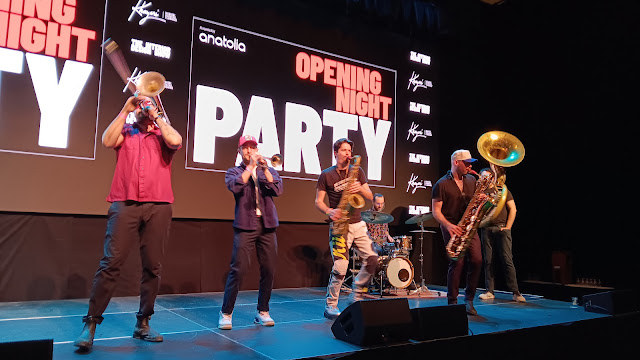Directed by Tarzan and Arab Nasser
ChinoKino rating: A-
Review by Allan Tong
The Toronto Palestine Film Festival opened last night with the strong Cannes-winning Once Upon A Time in Gaza. It's an artfully done genre picture about two small-time drug dealers and a corrupt cop, and takes place in two sections covering 2007 and 2009.
We follow Osama (charismatic Majd Eid, above in purple) and partner Yahya (Nader Arb Alhay, above right) who run a falafel joint in Gaza. Really, they deal in stolen pharmaceuticals that they hide in their sandwiches. They're small-time crooks who take bong hits and dream of better days under occupation. Both Hamas and Israel are tightening their grip around Gaza. Yahya can't visit his family in the West Bank an hour away because the Israeli authorities won't let him. He's never left Gaza and is literally stuck there. Meanwhile, Osama battles a corrupt cop (Ramzi Maqdisi has presence) who demands a cut of Osama's business. Osama is fearless, perhaps reckless.
Without giving away spoilers, the film jumps ahead two years. The switch is jarring, like the break in Hitchcock's Psycho or Wong Kar-Wai's Chungking Express. "So, where is this going?" I asked myself. Be patient, however, and you will see how the two acts connect. Let's just say that one day an enthusiastic director (Isaaq Elias) spots Yahya in a restaurant and wants to cast him as the hero in a cheesy action series, The Rebel. The government-backed TV program will showcase a heroic militant who died a martyr. Yahya hasn't acted a second in his life, but he looks perfect.
The satire continues as we see them film. The budget is so low that they use real bullets on set. Real Hamas militants mingle with fake ones, while Palestinians double as IDF soldiers. Everything is shot on the twisting streets of Gaza (in reality, Jordan for this film) as families look on. With such small circles overlapping, Yahya inevitably runs into the corrupt cop. Their paths collide in a surprise ending. At the end, I asked, What is martyrdom?
Does the story hold together? Yeah, surprisingly. Credit the Nasser Brothers for keeping the satire deadpanned so that the story's twists and turns are convincing. Their gritty approach keeps the movie grounded. Sets are relentlessly dark and claustrophobic. The viewer feels trapped like its anti-heroes. Life is absurd and painful in Gaza.
The Nasser Brothers began writing the film in 2015. Apart from quoting Trump's idiotic speech of building a riviera heard over the opening titles, Once Upon A Time in Gaza does not address what is happening now. (It's set in Gaza, because it's the brothers' hometown.) However, politics are inescapable in any film about Gaza. TV reports are sprinkled throughout the film, like a Greek chorus, about Israel building a wall and Hamas defiantly standing tall. That said, this is not a jingoistic picture. Politics is part of everyday life.
The Nasser Brothers captured the best director award at Cannes' Un Certain Regard last May. Each scene is skillfully executed. Performances are tight, particularly by Majd Eid who commands the screen. There are nods to filmmakers, such as Coppola. The writing and photography are tight.
Once Upon A Time in Gaza is the right choice to open (sold out) the Palestine Film Festival, which runs through October 3 at the TIFF Lightbox. Also programmed are art receptions, book signings, and a concert by the group Dam at Lee's Palace (sold out). Tickets and passes are available at TPFF.

















%2020241001_103520%20LR.jpg)



.jpg)
.jpg)
.jpg)
.jpg)
.jpg)
.jpg)
.jpg)
.jpg)
.jpg)

.png)
.jpg)

%20Spring%20Films%20and%203B-Produktion%20.png)
.jpg)
.jpg)
.jpg)
.jpg)
.jpg)
.jpg)
.jpg)
.jpg)
.jpg)
.jpg)
.jpg)
.jpg)
.jpg)
.jpg)
.jpg)
.jpg)
.jpg)
.jpg)
